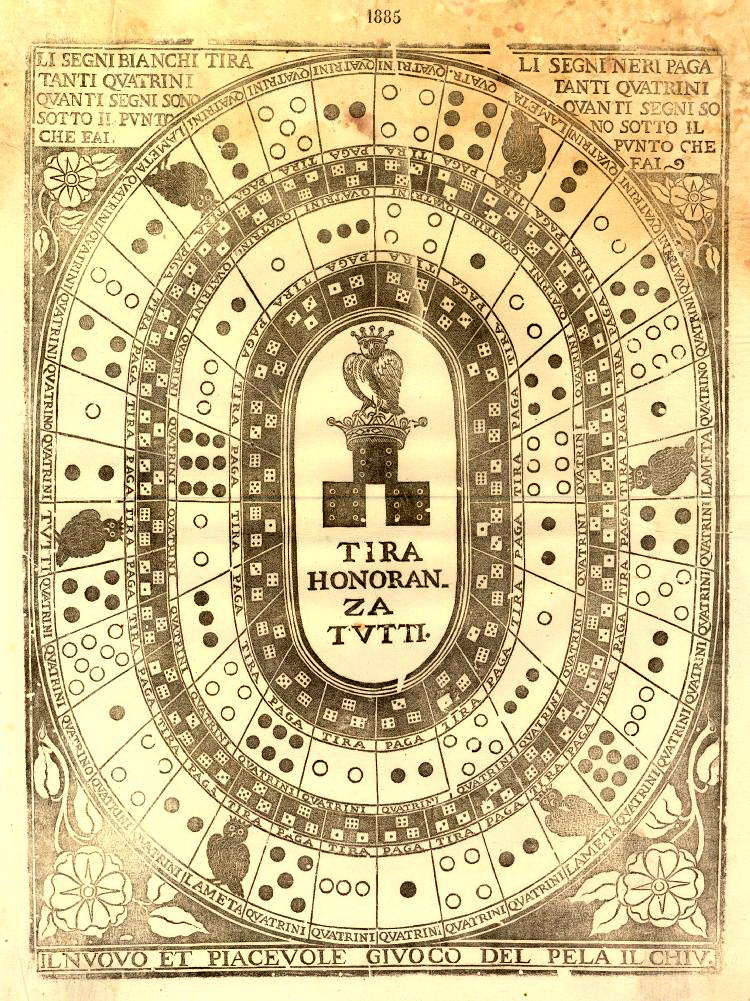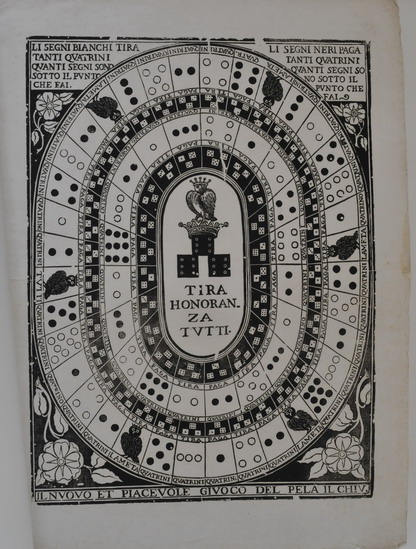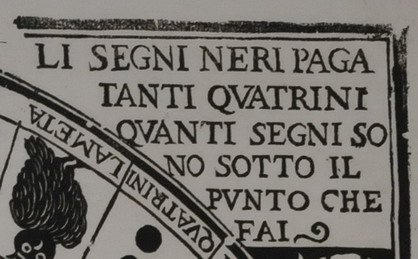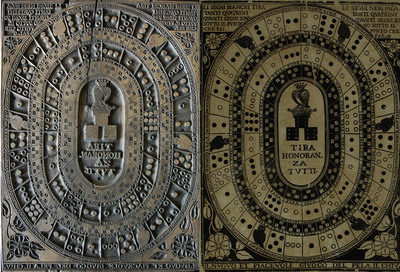Giochi dell'Oca e di percorso
(by Luigi Ciompi & Adrian Seville)
(by Luigi Ciompi & Adrian Seville)

|
Giochi dell'Oca e di percorso
(by Luigi Ciompi & Adrian Seville) |

|
 |

Torna alla ricerca giochi (back to game search) |
 |
| Nuovo (Il) et Piacevole Giuoco del Pela il Chiù | ||
 |
Versione stampabile
 |
Invia una segnalazione

|
     |
primo autore: | Anonimo |
| secondo autore: | Soliani | |
| anno: | 1750ca | |
| luogo: |
Italia-Parma |
|
| periodo: | XVIII secolo (2°-3°/4) | |
| percorso: | Gioco con i dadi | |
| materiale: | carta (paper) (papier) | |
| dimensioni: | 560X420 | |
| stampa: | Stampa su legno (bois gravé) (woodcut) | |
| luogo acquisto: | Donazione Lady C. Schreiber | |
| data acquisto: | ||
| dimensioni confezione: | ||
| numero caselle: | 56 | |
| categoria: | Lotterie, fortuna, gioco d'azzardo | |
| tipo di gioco: | Gioco con i dadi | |
| editore: | Soliani | |
| stampatore: | Soliani | |
| proprietario: | British Museum. Donazione Lady Charlotte Schreiber | |
| autore delle foto: | ©British Museum | |
| numero di catalogo: | 2283 | |
| descrizione: |
Gioco di 56 caselle (36 esterne, 20 interne) disposte su due ellissi concentriche (ovati). Mancano i caratteristici personaggi nelle caselle che vengono sostituiti da palle nere e bianche che indicano quanti quattrini si devono prendere o pagare. Il gioco si basa sul calcolo delle probabilità cioè sono 56 le combinazioni che si possono avere con tre dadi, corrispondenti al numero delle caselle distribuite nei due ovati. La corretta enumerazione delle probabilità con tre dadi, che consentisse il calcolo delle probabilità di ogni tiro, non era nota in Europa fino a buona parte del XVII secolo. Sebbene Gerolamo Cardano avesse esposto i fondamenti della teoria della probabilità nel suo libro, "Liber de ludo aleae", scritto intorno al 1564, questo non venne pubblicato fino al 1663. Il primo trattato sull'argomento ad essere ampiamente diffuso fu il "Libellus de Ratiociniis in Ludo Aleae", di Christiaan Huygens, pubblicato nel 1657. Fu il primo testo pubblicato sul calcolo delle probabilità e rimase il libro di testo standard sull'argomento per il mezzo secolo successivo. La diffusione del Gioco della Civetta è a cavallo di questa data ed è interessante prendere in considerazione fino a che punto il gioco sia stato influenzato parzialmente o completamente da queste considerazioni teoriche. In ogni casella una combinazione di tre dadi. Nell'ellissi esterna 6 civette (con la "raffa" 111/555) consentono di prendere la metà del piatto (LA META): la raffa di sei (666) fa vincere tutto (TIRA TUTTI). In alto a sinistra: "LI SEGNI BIANCHI TIRA TANTI QVATRINI QVANTI SEGNI SONO SOTTO IL PVNTO CHE FAI". In alto a destra: "LI SEGNI NERI PAGA TANTI QVATRINI QVANTI SEGNI SONO SOTTO IL PUNTO CHE FAI". In alto al centro è riportata una la data "1885". Al centro: "TIRA HONORANZA TUTTI". Negli angoli: motivi floreali. REGOLE: in alto e nelle singole caselle (PAGA/TIRA QVATRINI). CASELLE: con combinazioni di dadi. Ellissi esterna (in senso antiorario): TIRA 4. (3,4,5); PAGA 2. (4,5,2); TIRA 5. (6,3,2); PAGA 3. (4,4,2); TIRA LA META' (1,1,1); PAGA 2. (5,3,2); TIRA 3. (4,3,1); PAGA 4. (3,3,5); TIRA 1. (2,3,1); PAGA 2. (3,3,2); TIRA TUTTI (6,6,6); PAGA 5. (3,1,6); TIRA 8. (4,4,5); PAGA 1. (5,6,1); TIRA 4. (3,3,6); PAGA 2. (6,6,3); TIRA LA META' (5,5,5); PAGA 5. (4,2,6); TIRA 3. (1,1,6); PAGA 1. (4,4,1); TIRA 4. (2,2,4); PAGA 2. (2,2,1); TIRA LA META' (4,4,4); PAGA 8. (2,2,3); TIRA 3. (2,2,5); PAGA 2. (2,2,6); TIRA 5. (5,4,1); PAGA 4. (1,1,2); TIRA LA META' (3,3,3); PAGA 1. (1,1,3); TIRA 6. (1,1,4); PAGA 5. (1,1,5); TIRA 2. (1,2,4); PAGA 3. (1,2,5); TIRA LA META (2,2,2); PAGA 6. (1,2,6). Ellissi interna (in senso antiorario): TIRA 4. (4,5,5); PAGA 3. (5,5,1); TIRA 1. (3,3,1); PAGA 2. (5,5,2); TIRA 3. (5,5,3); PAGA 9. (5,6,4); TIRA 2. (4,6,1); PAGA 3. (4,4,3); TIRA 4. (6,6,4); PAGA 6. (6,6,5); TIRA 2. (4,4,6); PAGA 2. (6,4,3); TIRA 5. (6,6,1); PAGA 3. (6,5,2); TIRA 1. (5,3,6); PAGA 2. (5,3,1); TIRA 6. (6,6,2); PAGA 4. (5,5,6); TIRA 2. (3,4,2); PAGA 1. (3,3,4). NOTA: la matrice originale in legno è conservata presso il Fondo Soliani della Galleria Estense di Modena (Inv. 6627). Vedi anche esemplare della Collezione Ciompi, Arch. n°2780. REFERENZA 1 "British Museum" © The Trustees of the British Museum: 1893,0331.55 Title: Il Nuovo e Piacevole Giuoco del Pela il Chiu. Materials: paper. Description: Game board with four concentric ovals containing squares with dice or dots, interspersed with crowned owls; in the centre a crowned owl atop a crown resting on three dice showing sixes. Woodcut. Producer name: Print made by: Anonymous. School/style: Italian. Date: 18thC. Technique: woodcut term details. Dimensions: Height: 450 millimetres. Width: 340 millimetres. Inscription Content: Lettered with title at bottom and in centre beneath the owl "Tira/ Honoran-/ za/ Tutti". In the two top corners are the rules of the game. Curator's comments: (Text from Michael Bury, 'The Print in Italy 1550-1620', BM 2001, cat.103.) The name of the game means 'pluck the owl'. It involved throwing three dice, identifying the place that corresponded to the throw on either the inner or the outer oval and then carrying out the written instructions. 'T' means tira that is the instruction to take the number of quattrini ('Q') indicated; 'P' means paga that is the instruction to pay out the number of quattrini indicated. A throw of three sixes takes all. The idea will have been to buy one of these prints and stick it down onto a hard surface of some kind in order to form a game-board. The game is listed in the Vaccari stocklist of 1614 as 'Il giuco del pela Chiù', along with a small group of other games, including the famous 'Oca' (Ehrle, 1908, p.62). It also appears in the 1648 De Rossi inventory documenting the division of the inheritance from Giuseppe de Rossi the elder (Consagra, 1993, p.512). It evidently remained popular, for there were boards still being produced in the eighteenth century (Bertarelli). The language of the inscriptions points to a source in north-east Italy. This example has the address of Giovanni Battista Panzera, an engraver and printer from Parma who had shop in the Borgo in Rome. A number of Brambilla's works carry his address. Perhaps as a result of his contacts in the north of Italy, he had copies made of other prints that had been published there, most importantly Agostino Carracci's two great engravings after Correggio: the Madonna of St Jerome and the Ecce Homo.This is a late impression, andf stamped with the catalogue (?) number 1885. REFERENZA 2 IL NUOVO ET PIACEVOLE GIUOCO DEL PELA IL CHIU. "Jeu de la chouette". [Parme ?], vers 1750. Xylographie sur vergé en noir (42 x 56 cm.). Jeu composé de deux séries de cases disposées en 2 ovales concentriques, les coins ornés de motifs floraux. Les cases montrent des combinaisons de dés et le nombre de jetons correspondants ou des chouettes couronnées. Sorte de loto dont les cases portent la mention "tira" ou "paga". Le centre du plateau est occupé par une chouette couronnée surmontant trois dés et la mention "Tira honoranza Tutti". Les règles du jeu sont dans les angles supérieurs, le nom du jeu au bas de la planche. Il signifie "plumer la chouette". Le jeu consiste à jeter trois dés dont la combinaison indique une case contenant des instructions et points. Bertarelli, "L’imagerie populaire italienne", p. 61. (Oberlé, Gérard - Pimpaneau, Tristan) |
|
| bibliografia: |
1) CITOLINI, Alessandro: "La tipocosmia di Alessandro Citolini, da Serraualle". In Venetia: appresso Vincenzo Valgrisi, 1561, p. 484. 2) FRANCIOSINI,Lorenzo: "Vocabulario español e italiano", Volume 2 Roma: en la Emprenta de la Reu. Camera Apostolica, 1638, p. 428. 3) LA MARINIERE, de: "La Maison Academique: contenant un recueil general de tous les jeux divertissans pour se rejouyr agreablement dans les bonnes compagnies", par le sieur D.L.M. [de La Marinière]. A Paris: chez Robert de Nain et Marin Leché, M.DC.LIV 4) HOWELL, James: Lexicon tetraglotton, an English-French-Italian-Spanish dictionary. London: by J.G. for Samuel Thomson, 1660, p. 532. 5) VINCK, Eugène, Baron de: "Iconographie du Noble Jeu de l’Oye. Catalogue descriptif et raisonné de la Collection de Jeux formé par le Baron de Vinck". 126 Jeux du XVIIIe au débùt du XIXe siècle. FR. J. Olivier Libraire, 11 Rue des Paroissiens, Bruxelles, 1886. 6) D’ALLEMAGNE, H. R. : "Le Noble Jeu de l’Oie", Paris, Libraire Gruend, 1950. 7) NEGRI, Ilio – VERCELLONI, Virgilio: "I Giochi di Dadi d’Azzardo e di Passatempo dei Gentiluomini e dei Pirati" Introduzione di Caterina Santoro, Lerici Milano, 1958. 8) VON WILCKENS, L. : "Spiel, Spiele, Kinderspiel (exhibition catalogue)", Germanisches Nationalmuseums, Nuernberg, 1985. 9) Catalogo Mostra: "Costume e società nei giochi a stampa di Giuseppe Maria Mitelli", Electa Editori Umbri Associati 1988. 10) BERTI, Giordano - VITALI, Andrea: “La vite e il vino. Carte da gioco e giochi di carta”, Fondazione Lungarotti, Edigraf, Roma 1999. 11) BURY, Michael: “The Print in Italy: 1550-1620”, BM 2001. 12) BUIJNSTERS, P.J. and Buijnsters-Smets,L. : "Papertoys", Zwolle, Waanders, 2005. 13) PLOCK, Phillippa - SEVILLE, Adrian: "The Rothschild Collection of printed board games at Waddesdon Manor", in XIIIth Board Game Studies Colloquium, Paris, 14-17 April 2010. 14) DEPAULIS, Thierry: “Trois jeux imprimés du début du XVIIe siècle par la veuve Petit à Paris”, Arbeitskreis Bild Druck Papier , Band 16 2011 15) MILANO, Alberto: "Giochi da salotto. Giochi da osteria, nella vita milanese dal Cinquecento all'Ottocento". Edizioni Gabriele Mazzotta, Milano 2012. 16) DEPAULIS, Thierry: "Three early 17th-century printed games by the Veuve Petit in Paris". In: Of Boards and Men: Board Games Investigated. Proceedings of the XIIIth Board Game Studies Colloquium, Paris, 14-17 April 2010, collected and edited by "Thierry Depaulis", [Paris], 2012, p. 75-89. 17) DEPAULIS, Thierry: "Vaugeois, tabletier, connu et inconnu" (2e partie). Le Vieux Papier fasc. n°422, 2016. 18) PARLAK, Ömer Fatih: "The Image of the Turk in Early Modern Board Games and Playing Cards". PHD THESIS. Universitat Autonoma de Barcelona, 2019. 19) SEVILLE, Adrian: "The Game of the Owl". In: "Vieux Papier", Aprile - Giugno 2021. |
|
Vai alla ricerca giochi Vai all'elenco autori